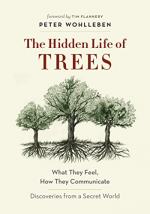|
This section contains 742 words (approx. 2 pages at 400 words per page) |

|
The Hidden Life of Trees Summary & Study Guide Description
The Hidden Life of Trees Summary & Study Guide includes comprehensive information and analysis to help you understand the book. This study guide contains the following sections:
This detailed literature summary also contains Topics for Discussion on The Hidden Life of Trees by Peter Wohlleben.
The following version of this book was used to create this guide: Wohlleben, Peter. The Hidden Life of Trees. Random House, 2016. First edition.
The original has been translated from German by Jane Billinghurst.
Peter Wohlleben shares his experiences from decades of observing the forest. He often noticed peculiar things, which he then investigated. Thus he learned of unknown workings of trees, of the organisms that co-exist with trees, and the whole forest. He writes of both his observations and the properties and processes that he looked into. Often, Wohlleben begins with an anecdote and explores from there but, even once he has reached quite some depth in a biological phenomenon, he has not broken from his story-telling style. And thus he shares insights into biological processes that are indeed unknown to many, but that may also not be regarded as significant enough to consider at length. Wohlleben shows how minute factors come together and that, thus, even seemingly futile elements are important.
His primary purpose in the book is to reveal that trees have more complex capabilities than most people are aware of. This begins with communication between them and extends to regulating the climate around them, ‘learning’ from experience, exchanging nutrients, complex defense processes, transporting water into landlocked countries, ‘telling time,’ ‘making decisions,’ migrating, activating genes or thickening cell walls to adapt to their environment, and cleaning air. Many of these capabilities are introduced by an example of when Wohlleben observed the characteristic in a forest, and they are often explored throughout a chapter. His writing is almost flow-of-consciousness in its progression of ideas, including many tangents and not having a linearly structured scheme of organization.
Wohlleben explains that trees can use gases carried by the wind as well as chemical signals through fungal networks to communicate danger to each other. The trees can grow more leaves to increase humidity and temperature, change the acidity of soil by adding their decaying matter to it, increase the nutrients available to the roots in cooperation with fungi, and thicken clouds above them by releasing volatile compounds. He found that they will use less water for the rest of their lives after suffering a shortage one year and reports that their shrub cousins can learn that a part of their surroundings is harmless. As well as that they are capable of sending each other nutrients through an underground connection of their roots, sometimes bridged by fungi. He writes of trees’ reaction to an insect nibbling on a leaf – sending bitter or toxic substances there to deter the critter. Trees also take preventative action by releasing compounds into the air that ward off their feasting friends. Additionally, they are capable of thickening their bark and drowning a bug or fungus moving into its outer layers. The reader learns that rain is only capable of travelling further than 400 kilometers inland from an ocean due to forests. They hear of leafy giants counting the number of warm days to assure that their leaves will survive, waiting until the daylight time has reached thirteen hours. The masses of needles and leaves growing bare millimeters filter particulates and gases toxic to humans.
Another major point Wohlleben illustrates is the interconnectedness of trees and in fact all parts of the forest. He also shows that this can be generalized further onto the interconnectedness of all the parts of any ecosystem, with the Earth being the biggest ecosystem that we can describe effectively.
He tells of the “wood wide web” (the underground root and fungus system that can exchange nutrients and information), scent-based communication, pioneers making fields habitable for other trees to move in, species that feed and protect the trees (fungi, woodpeckers, cardinal beetles), the development of an ecosystem’s constellation, the organisms that feed off trees, the organisms that live in trees, the subsurface life that makes soil what it is, the sub-habitats in trees, animals helping tree reproduction, plants that live on trees (some parasitic, some not).
Wohlleben shows that trees support each other in various ways. They adjust their microclimate and other elements of their habitat together, share nutrients, warn each other of attacks, sometimes help out through a coincidence. And Wohlleben also demonstrates that this works at another level, as trees are supported by and support the other organisms in the forest. He points out to the reader that this system actually functions at every level, and is a key element to all life.
Read more from the Study Guide
|
This section contains 742 words (approx. 2 pages at 400 words per page) |

|



